Chapter-5 PMA Write-up
Introduction :
Analyze the malware found in the file Lab05-01.dll using only IDA Pro. The goal of this lab is to give you hands-on experience with IDA Pro. If you’ve already worked with IDA Pro, you may choose to ignore these questions and focus on reverse-engineering the malware.
Q1 : What is the address of DllMain?
Answer :
After using a filter and search for DllMain we will see that its address is : 1000D02E.

Q2 : Use the Imports window to browse to gethostbyname. Where is the import located?
Answer :
Using a functions-filter and search for the “gethostbyname” import will leads us to its location in “100163CC”.

Q3 : How many functions call gethostbyname?
Answer :
By using the Xref graph view we will see that the “gethostbyname” import is called 5-times.
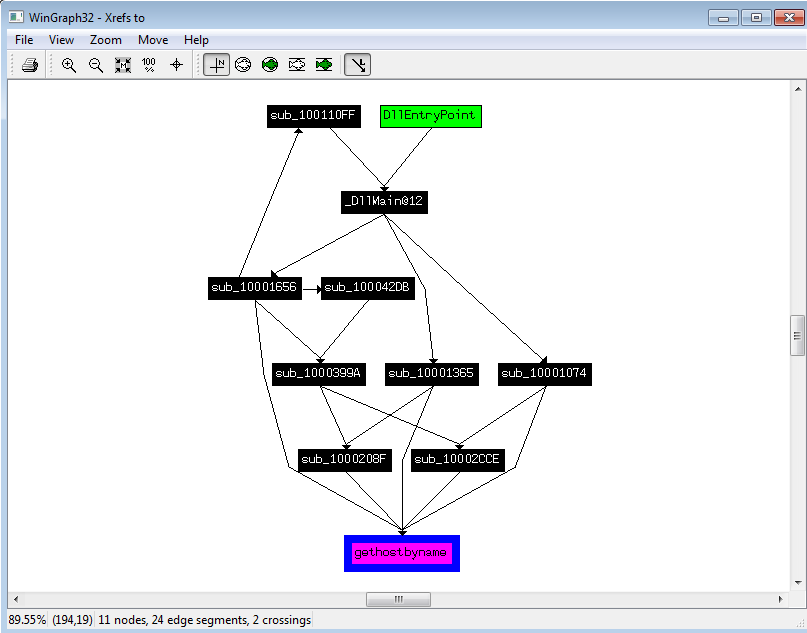
Q4 : Focusing on the call to gethostbyname located at 0x10001757, can you figure out which DNS request will be made?
Answer :
By jumping to 0x10001757 we will see the instruction: mov eax, off_10019040 Along with an IDA-PRO comment says : “[This is RDO]pics.praticalmalwareanalys” which is the value stored in eax (the parameter of our function) So the requested DNS is: pics.practicalmalwareanalysis.com.

Q5 : How many local variables has IDA Pro recognized for the subroutine at 0x10001656?
Answer :
By using pseudocode view we wil see that there are 23 local variable ( the ones with negative offsets).
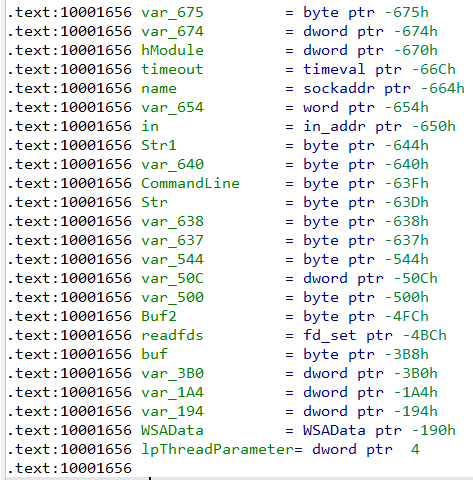
Q6 : How many parameters has IDA Pro recognized for the subroutine at 0x10001656?
Answer :
Only one that IDA Pro has recognized, It has been named to “lpThreadParameter”

Q7 : Use the Strings window to locate the string \cmd.exe /c in the disassembly. Where is it located?
Answer :
After using a string filter for the string contains “\cmd.exe /c”, by double clicking it we will find it at “10095B34”.

Q8 : What is happening in the area of code that references \cmd.exe /c?
Answer :
-
Now we see that some values are pushed into the stack that catch out eyes like “quit”, “exit”, “minstall” and “inject”.
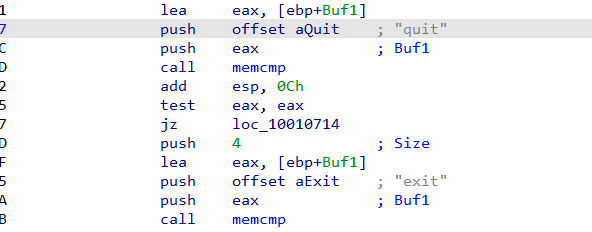
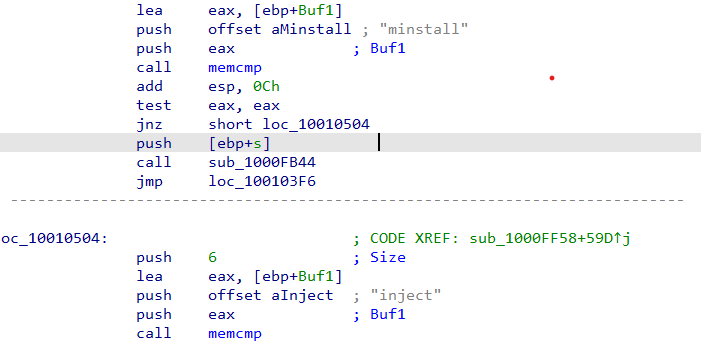
-
Scrolling down more, we an array say “Encrypt magic for this Remote Shell Session”.
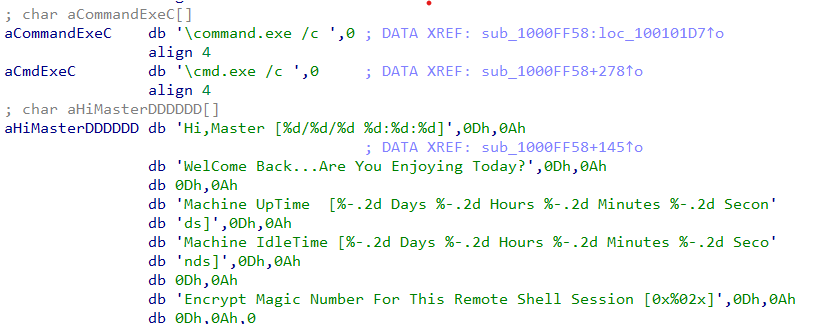
-
I don’t know what is happening here for certain, best guess will be that this is a remote shell session.
Q9 : In the same area, at 0x100101C8, it looks like dword_1008E5C4 is a global variable that helps decide which path to take. How does the malware set dword_1008E5C4?
(Hint: Use dword_1008E5C4’s cross-references.)
Answer :
-
The “dword_1008E5C4” is in .data section, So using Xref we will see 2 functions read its data and only one writes it
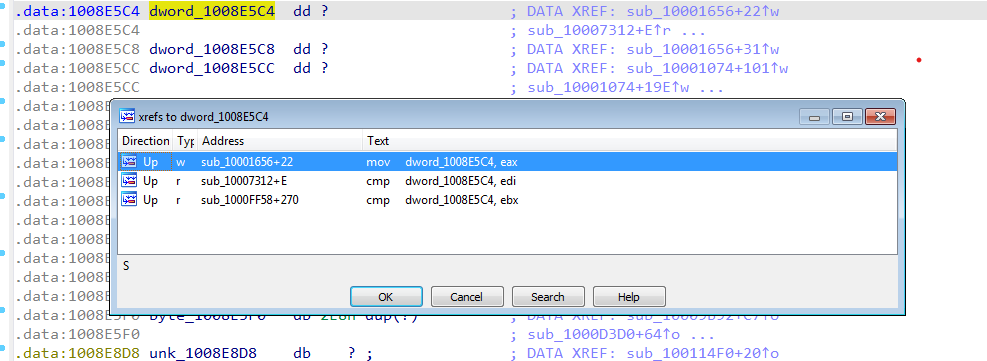
-
By double clicking on it, we notice that the “dword_1008E5C4” stores what is in EAX which is the returning value of calling sub_10003695

-
By gitting into sub_10003695 we will see a call to “GetVersionExA” function which is responsible for gathering some information about the OS version (Read more from here) and compare it with “2” later in “0x100036B7”

In Breif : the dword_1008E5C4 stores the OS version.
Q10 : A few hundred lines into the subroutine at 0x1000FF58, a series of comparisons use memcmp to compare strings. What happens if the string comparison to robotwork is successful (when memcmp returns 0)?
Answer :
-
As we see, if the string comparison to robotwork is successful (when memcmp returns 0) the The jnz at will not be taken and the call to “sub_100052A2” will occure,

-
By going to “sub_100052A2” we will see that it gather some information about “SOFTWARE\Microsoft\Windows\CurrentVersion”
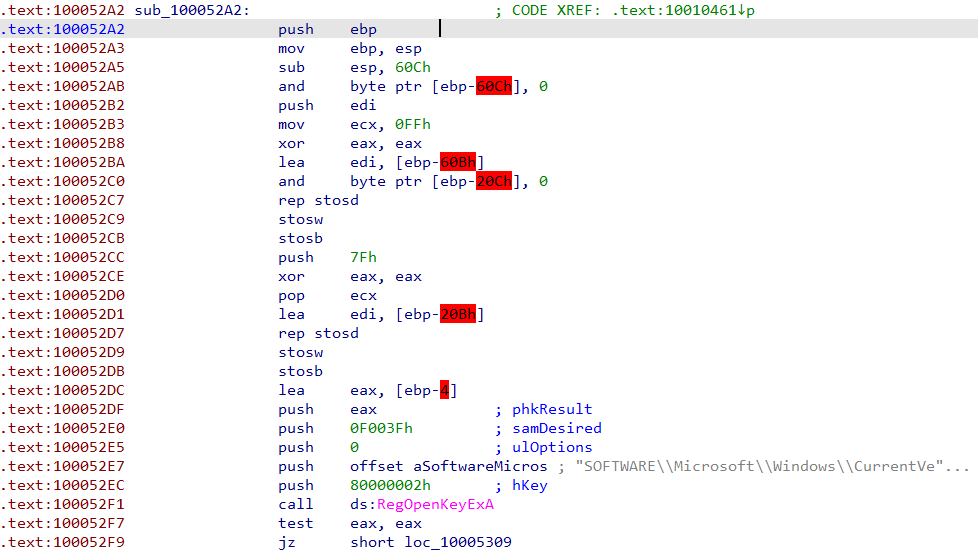
Q11 : What does the export PSLIST do?
Answer :
-
After finding PSLIST and by using the graphical view we will see that there is to ways the execution my follow depending on te result of calling “sub_100036C3”
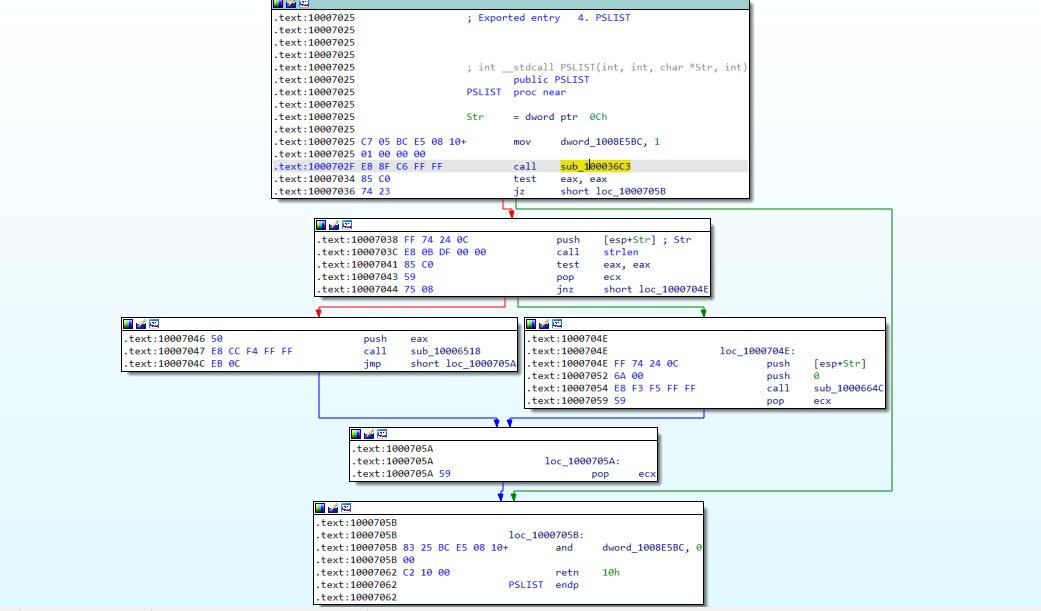
-
The “sub_100036C3” looks like it gathetr some information about “OS version”.
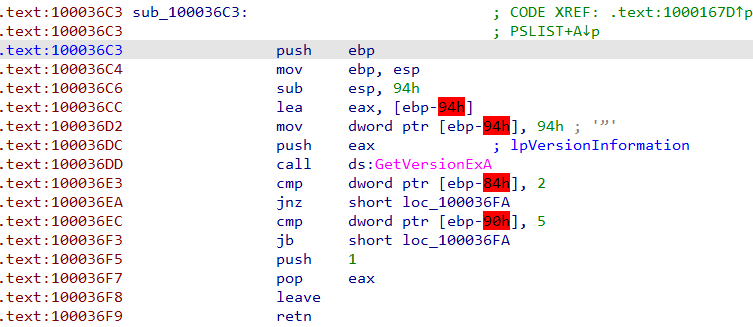
-
Both ways will lead us to “loc_1000705B” which sent out these information via network socket.
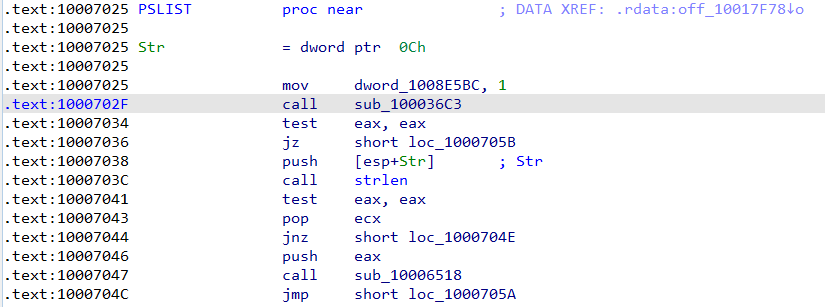
Q12 : Use the graph mode to graph the cross-references from sub_10004E79. Which API functions could be called by entering this function? Based on the API functions alone, what could you rename this function?
Answer :
Using Xref from “sub_10004E79”, we will see that it uses “ GetSystemDefaultLangID”, “sprintf”, “strlen”, so I would name it “_get_language_ID”
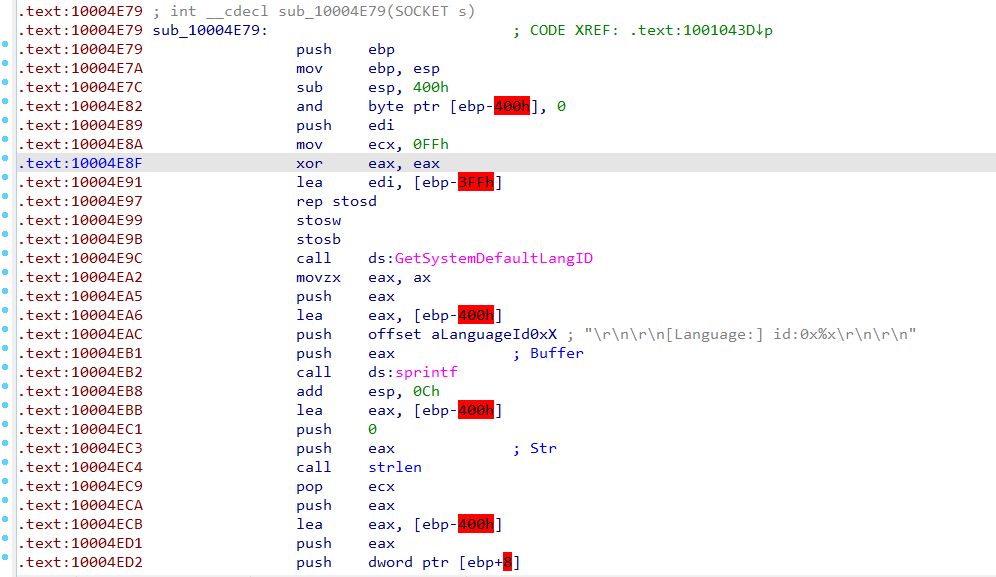
Q13 : How many Windows API functions does DllMain call directly? How many at a depth of 2?
Answer :
Using a custom cross-reference graph
for “0x1000D02E”, we will see that there is 4 functions called directly by “_DllMain@12”.
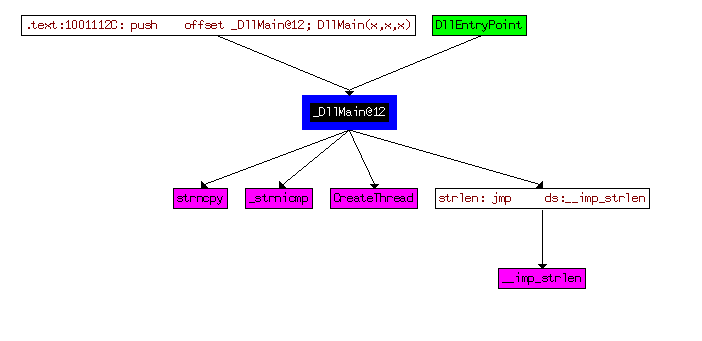
Q14 : At 0x10001358, there is a call to Sleep (an API function that takes one parameter containing the number of milliseconds to sleep). Looking backward through the code, how long will the program sleep if this code executes?
Answer :
The sleep function takes eax as it’s parameter, by going back in code we find that:
- eax stores the string “[This is CTI]30”.
- by adding “0D” the pointer moves by 13 offsets leaving only ‘30’ in eax
- calling atoi is just a method to convert string-type to int-type.
- At last the ‘30’ is multiplied by ‘1000’ and stored in eax
- finally eax is passed to “Sleep”, So the program will sleep by 30,000 milli_second (30 second).

Q15 : At 0x10001701 is a call to socket. What are the three parameters?
Answer :
Looking at this address we can see a call to socket which takes 3 parameters (protocol, type, and af) all of which are pushed to the stack prior to the call

Q16 : Using the MSDN page for socket and the named symbolic constants functionality in IDA Pro, can you make the parameters more meaningful? What are the parameters after you apply changes?
Answer :
By going to the MSDN Socket Function we will be able to see the meaning of each parameter :
| parameters | symbolic_constants | meaning |
|---|---|---|
| 2 | AF_INET | The Internet Protocol version 4 (IPv4) address family. |
| 1 | SOCK_STREAM | A socket type that provides sequenced, reliable, two-way, connection-based byte streams with an OOB data transmission mechanism. This socket type uses the Transmission Control Protocol (TCP) for the Internet address family (AF_INET or AF_INET6). |
| 6 | IPPROTO_TCP | The Transmission Control Protocol (TCP). This is a possible value when the af parameter is AF_INET or AF_INET6 and the type parameter is SOCK_STREAM. |
Q17 : Search for usage of the in instruction (opcode 0xED). This instruction is used with a magic string VMXh to perform VMware detection. Is that in use in this malware? Using the cross-references to the function that executes the in instruction, is there further evidence of VMware detection?
Answer :
-
By searching for “ED” as a sequance of bytes we can see that it’s in use with the string “VMXh” in “sub_10006196”

-
Usin an “Xref to” graph for sub_10006196 will tell us that this function had been called 3-times by “InstallSB”, “InstallSA” and “InstallRT”.
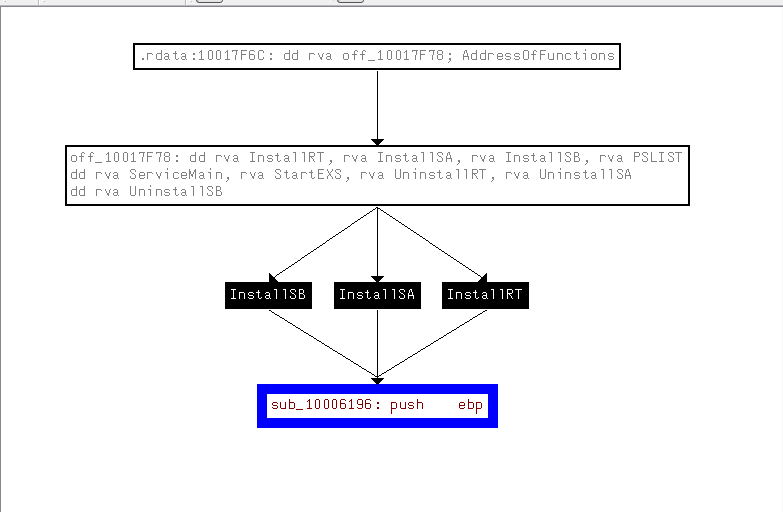
-
By diving into each one of them we will found a comparsion that decide if th VMWare is deticted go to “loc_1000D870” then cancel the installaion, if not go to “loc_1000D88E” and continue.
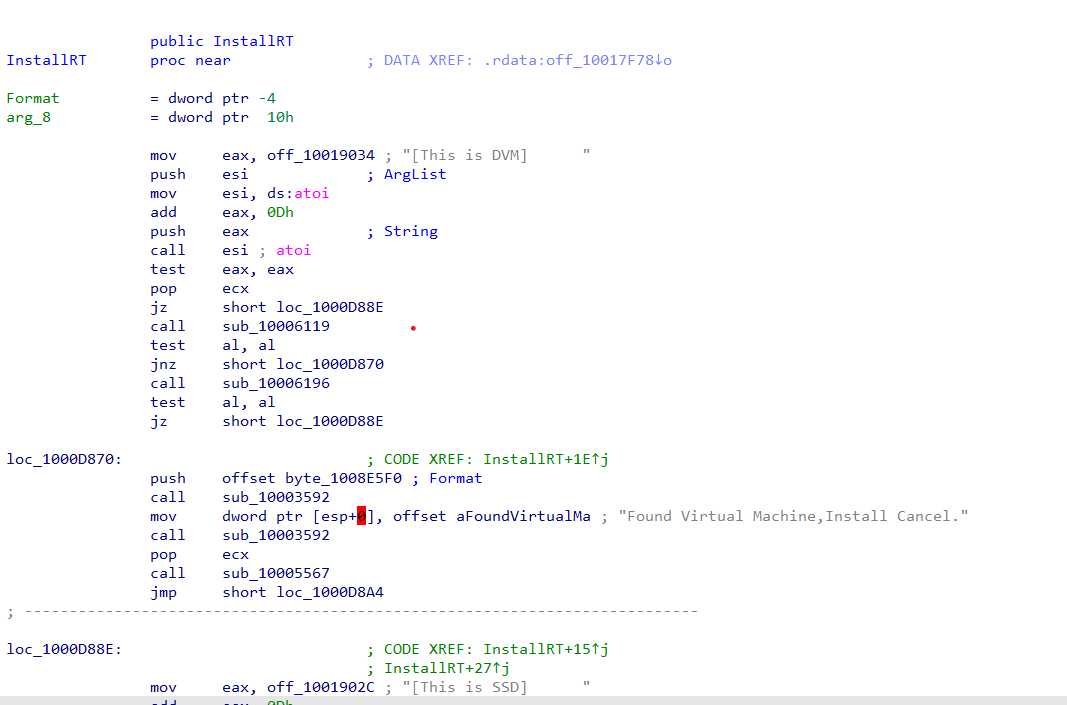
Q18 : Jump your cursor to 0x1001D988. What do you find?
Answer :
By going to “0x1001D988” all we can see is a collection of random data.
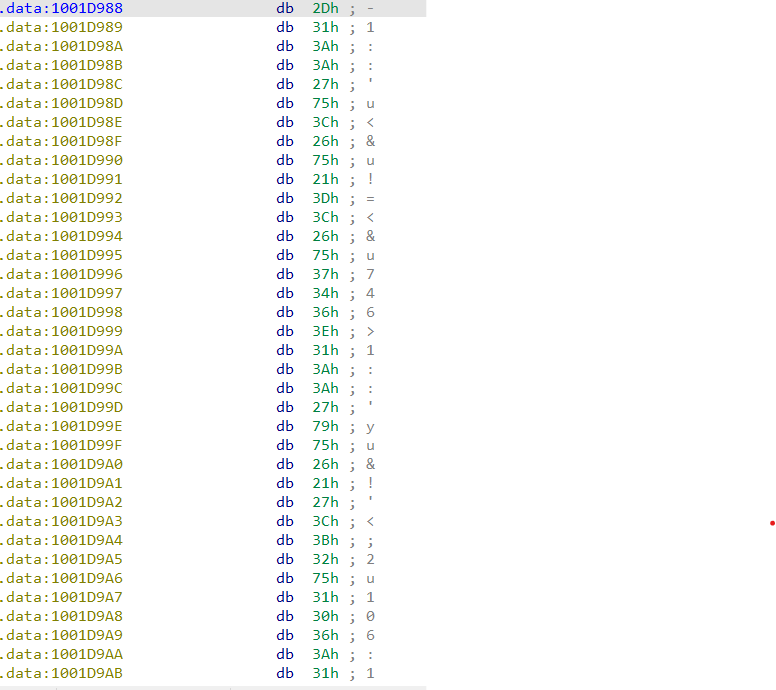
Q19 : If you have the IDA Python plug-in installed (included with the commercial version of IDA Pro), run Lab05-01.py, an IDA Pro Python script provided with the malware for this book. (Make sure the cursor is at 0x1001D988.) What happens after you run the script?
Answer :
By runing the py_Script we will see that these random data are changing, but still random.
Q20 : With the cursor in the same location, how do you turn this data into a single ASCII string?
Answer :
By pressing (A key) we can combine the whole string in ASCII form, now we can see this random text before applying the script :
-1::’u<&u!=<&u746>1::’yu&!’<;2u106:101u3:’u%’46!<649u849”4’0u4;49,&<&u47uo dgfa
turns into that readable text after applying it :
xdoor is this backdoor, string decoded for practical malware analysis ab :)1234
Q21 : Open the script with a text editor. How does it work?
Answer :
By opining the script in VScode we see

Now we understand what happend:
- The variable “sea” stores the location of the curser which is our start address.
- The for loop is set to excute it’s internal instructions for the next (50) memory address.
- The internal instructions of the for loop are to preformed an (XOR) operation for every time the loop happened.
- The overview of the code is that it does an (XOR) operation for our random (50) data which will turn them too more human readable data.
THE END